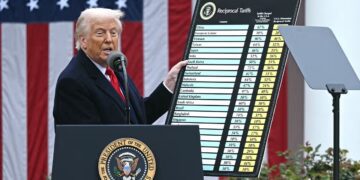By John F. Di Leo -
“Hey, do we have seventy-five bucks each?”
“Seventy-five bucks?”
“Yeah, seventy-five bucks each.”
“You mean for you and me, so it’s $150?”
“Well, it’s for the kids too, so it’s $375, total.”
“Oh. Well…. I don’t know… Depends.”
“Can we do it or not?”
“Well, I don’t know, when would we need it? Is this for today?”
“I’m thinking, we could charge it… or you could volunteer for some overtime for a couple weeks… or I could hock Grandpa’s watch….”
“Well, it depends. Tell me… What’s all this for?”
A Rational Discussion
If you’re a typical American, you have been on edge throughout this dialogue. The last question should have been the first one:
What’s all this for?
In any American household, there are choices to make all the time. Money plays a role in these choices, but it’s not the only thing at issue. The first question is whether a thing is worth doing at all, and then we consider its value, then finally, if it seems generally worth doing, we consider whether or not we can afford it, ready to say No if we can't.
If that $375 covers brake pads on the family minivan, then yes, we have to do it. We may have to charge it, borrow it, volunteer for extra hours at work, or postpone doing something else, but functioning brakes are an imperative.
On the other hand, if it’s $75/ticket for a Trace Adkins or Aaron Tippin concert, then different questions arise. Maybe only two of us love the performer. Maybe when you add in the transportation and concessions, it’s really a lot more expensive than it looks. Maybe there are cheaper seats in the balcony, worth considering. Maybe we should check the date first to see if we’re even free. And then we get into the questions of whether it’s a reasonable expense or not, considering our other, more important expenses, considering our income, right now.
Or maybe it’s $375 for a really terrific deal, an annual jelly-of-the-month club with no cancellation, no refunds.
Price is relative. $375 for brake pads is a necessity; $375 for concert tickets is a luxury. And $375 for a food club is a frivolity.
These numbers all have different meanings, depending on your income level, the size of your family, even your age and location.
In short, to refer to a proposed expense simply by its price tag is not simply wrong, it’s absolutely nonsensical. The subject matter in any discussion about spending must be focused on what the spending is for, not on the amount alone.
The So-Called $3.5 Trillion Build Back Better Act
For much of 2021, the discussion in Washington – by both pols and pundits alike – has focused on a “Build Back Better” Act, a combination of all the campaign promises of all the 2020 Democrat Party primary season’s presidential candidates, even such utterly toxic proposals as the Green New Deal.
This bill – presented as an “infrastructure plus” bill – has been touted as the absolutely imperative second part to the “more reasonable” $1.1 trillion infrastructure bill that actually included some infrastructure.
The $1.1 trillion already passed – like all infrastructure bills – should be a stimulus of sorts, a hodgepodge of hopefully-worthwhile building projects that would deliver useful things (roads, bridges, utility upgrades), providing long term benefits to their communities, and creating a burst of immediate jobs for the unemployed.
While that $1.1 trillion wasn’t anywhere near as efficient, responsible, or ultimately helpful as a federal expenditure ought to be, at least it was somewhat focused on bricks and mortar. It’s going to cost a lot more than $1.1 trillion, and it contains a heck of a lot of things that aren’t infrastructure… but even so, it’s much closer to what the public thinks of when we hear the term “infrastructure” than this new scam.
In fact, the so-called $3.5 trillion “part two” of this infrastructure plan has almost nothing to do with infrastructure, will cost at least $5.5 trillion when real math is applied, and is far more transformative in controversial ways than a real infrastructure bill would be.
Let’s consider a typical item in a real infrastructure bill: Should we spend $460 million to replace the John A Blatnik Bridge connecting Duluth, MN with Superior, WI? A rational discussion might consider such issues as whether the current one really is dangerous (it is), whether other existing routes are available (they are), whether Wisconsin and Minnesota each have a quarter billion to spare for the project (who does?), whether it can or should be postponed…
There are tons of questions about each such expenditure. They need to be discussed, one by one, and considered fairly and honestly by everyone affected, both in terms of funding the project and in terms of living with the decision.
This so-called $3.5 trillion spending plan has hardly any infrastructure in it to speak of. It’s about setting up new offices and agencies to distribute new cash subsidies. It’s about pouring federal funds into activities that have never been federally-funded before.
- The so-called $3.5 trillion spending plan is about bribing car manufacturers to build more electric cars, even though they can build perfectly good gasoline-powered and hybrid cars without federal help.
- It’s about installing tens of thousands of electric car charging stations, to enable government agencies to replace the private sector’s network of privately-owned gas stations.
- It’s about funding the early years of a new federally-organized universal preschool program, in a way that makes states dependent on federal funds that are designed to expire, so that the states soon have to find a way to pay for this new and unaffordable obligation.
- It’s about creating tons of new welfare benefits, disguised as salary supplements (they call them refundable tax credits) to create or pad various "favored" careers such as child care, senior care, and social work.
- It’s about having the federal government directly pay to make community colleges free to everyone, or almost everyone, when in fact community colleges are already the least expensive kind of colleges, thanks to both low costs and existing federal grants and tax credits. It's about nationalizing a local or state function.
- It’s about adding tons of new benefits to Medicare, such as dental and vision coverage, even though there are existing private insurance programs for such needs that are far more efficient than the government alternative would be.
- It’s about forcing additional federally-managed Medicaid-like programs on the dozen states that have intentionally chosen to trust the private sector with such matters rather than doing it at the state level.
- It’s about closing coal, natural gas, and oil power plants – all over the country – in an effort to move the country from less than 10% solar and wind power to over 80% by 2030 (which would require plastering practically the entire country with Chinese solar panels and Chinese windmills, due to both the inefficiency of these sources and China’s domination of that industry).
There’s more in it than that. A lot more. This is just a hint of what’s in this outrageous bill.
The Democrats are clever; they’re presenting it as a budget reconciliation bill, because there’s spending in it.
By presenting it this way, they can focus the conversation on the budgetary aspects. It’s this much money; can we do it? Do you support it or not? Will you vote for this necessity (every bill is a necessity from the perspective of its advocates) or not? How will we fund it? Which taxes shall we raise so that we can pretend that this $3.5 trillion or $5.5 trillion – or more! – bill is "paid for?"
But please, let's step back a moment. Knowing what we now know about its contents… is this monstrosity really about spending?
Or is this bill really about a thousand transformations – about undercutting some types of workers and boosting others – about creating government-funded jobs for one class of people and making the private-sector jobs held by other classes pay for it all?
In the end, to be honest, isn't this really about reaching ever deeper into the pockets of America’s workers – the blue collar and white collar and grey collar workers of our factories and distribution centers, our engineers and our machinists, our salesmen and our buyers, our entrepreneurs and our middle managers, our customer service clerks and retail shop keyholders – and crippling them all with a tax burden that eliminates their ability to move up in life?
Proper Constitutional Debate
One thing should be clear by now: The warping of the federal budget process, which has frankly been going on for half a century now, has reached its ultimate logical conclusion.
The old idea – certainly the Founders’ plan when the Constitution was designed – was that new ideas, new proposals for the federal government would be tackled one by one, each with their own individual, targeted debates.
In the early years of implementation of the Constitution, there were plenty of hard-fought battles on the questions of a federal bank, the proposed assumption of states’ war debts, the situation of the national capital city, the treaty with England. Each one individually discussed, in the newspapers and town halls as well as at Congress. And the president saw his primary job as evaluating their constitutionality if they were passed; George Washington vowed to never sign an unconstitutional bill.
Under the Constitution's design, if someone proposed an unconstitutional idea, the debate would move to an effort to seek a Constitutional amendment to allow it.
Gradually, over the centuries, Congress fell into a “Continuing Resolution” approach, in which we assumed every year that last year’s budget should be increased by something well above the inflation rate, plus whatever other increases Congress agreed to in various existing programs. The largely-unspoken deal with the American public was that Congress would publicly debate changes in the rate of increase… saving the time and bother of a thousand individual debates on existing programs. But new ideas, not just new spending, but new projects, new initiatives, new corruptions of the American system, must still be individually debated, separately from the bean-counter approach taken in the annual budget debates.
The Democratic Party has now completely abandoned this distinction. They view our Constitution as too limiting; they view public debate as too revealing.
Today's Democratic Party leadership has decided – entirely on their own – that mere winning or stealing an election counts as a mandate, just like a legitimate landslide victory would. Even if they only control a 50/50 Senate by the skin of their teeth and a tie-breaking vote by their California ringer, they will act with the impunity of a monarch.
This bill is full of new approaches, new corruptions to our system that literally demand individual debate, but the Democrats refuse to consider such a route. Why? Because they know full well that most or even all of these projects would go down in flames, under the scrutiny of a watchful public. They only have a chance of all this if they can bury the proper debate under a concealing tarp: the guise of a simple question of tax rates.
The Democrats learned long ago that they can win a debate on most spending matters by convincing enough voters that someone else will pay for it. Make it a big enough number, and the majority of the public will just be relieved that it’s someone else’s taxes going up, not theirs.
It is time to call the Democrats on this corrupt technique. We must return to the days of debating every issue individually.
If the left thinks that the American people will support papering over the entire country with (unrecyclable) Chinese solar panels and windmills… let have that debate.
If the left thinks the American people will happily shut down all our gas stations in favor of federal electric charging stations that will quickly run out of power because even the existing grid (let alone the vastly diminished grid that would follow massive conversion to solar and wind) cannot possibly support them… let them have that debate.
If the left thinks that the American people will support making it impossible for the factory foreman or the oil rig roughneck or the over-the-road trucker to afford a house, because he’s being overtaxed to overpay bureaucrats and Beijing bag men… let them have that debate.
It isn’t just that this $3.5 trillion dollar infrastructure bill is dishonest and unamerican from start to finish. It’s that the whole slimy process of sneaking it by the American people is unethical.
We should compliment the few Democrats, such as Senators Kyrsten Sinema and Joe Manchin, who have had the courage to stand up to this process (so far, at least).
And we should recognize from Sinema's and Manchin's lonely position how utterly dishonest, corrupt and immoral the vast majority of the Democratic Party is today.
This thing isn’t about dollars; it isn’t about taxes; it isn’t even about the lifetime of debt into which it condemns future generations.
This thing is about driving our country – not just our economy, but our very way of life – right off a cliff, hitting the accelerator and denying it all the while.
Somehow, it must be stopped… not just this bill, but the whole corrupt annual technique behind it.
Copyright 2021 John F Di Leo
John F Di Leo is a Chicagoland-based trade compliance trainer, transportation manager, and writer. His columns have been found in Illinois Review since 2009.
John's first book, a collection of his short stories about voting fraud originally run in Illinois Review, is available on Amazon under the title "The Tales of Little Pavel."
The first volume of his new fiction series, "Evening Soup with Basement Joe," a political satire, set in a parallel universe not quite identical to the Earth of 2021… in which a confused, crooked old man becomes president, and a young aide brings down his nightly bowl of soup and engages him in conversation, in a losing battle to restrain the onset of dementia. Volume one covers the first ninety days of this strange new world, and is also available from Amazon in either eBook or paperback!
Don't miss an article! Use the free tool in the margin to sign up for Illinois Review's free email notification service, so you always know when Illinois Review publishes new content!








